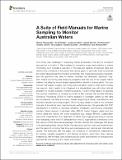A suite of field manuals for marine sampling to monitor Australian waters
Abstract
One of the main challenges in assessing marine biodiversity is the lack of consistent approaches to monitor it. This threatens to undermine ocean best practice in marine monitoring, as it impedes a reduction in the bias and variance of sampled data and restricts the confidence in the advice that can be given. In particular, there is potential for confounding between the monitoring methods, their measured ecological properties, and the questions they seek to answer. Australia has developed significant long-term marine monitoring and observing programs and has one of the largest marine estates, including the world’s largest representative network of marine parks. This new network will require ongoing monitoring and evaluation, beyond what direct funding can support, which needs to be integrated in a standardized way with other national programs to develop sufficient monitoring capacity. The aim of this paper is to describe the process undertaken in developing a suite of field manuals that provide Standard Operating Procedures (SOPs) for marine sampling in Australian waters so that data are comparable over time and space, thereby supporting a robust, cost-effective, and objective national monitoring program. We encourage readers to refer to the complete manuals of interest at www.nespmarine.edu.au/field-manuals. We generally limit SOP development to benthic or demersal sampling, (multibeam, autonomous underwater vehicles, baited remoted underwater video (BRUV), towed imagery, grabs and box corers, sleds and trawls), with a few exceptions (e.g., pelagic BRUVs). Collaboration was a key characteristic of our approach so rather than single groups trying to impose their standards, more than 70 individuals from over 30 organizations contributed to the first version of this field manual package. We also discuss the challenges that arose while developing these national SOPs, the associated solutions that were implemented, and the plans for ensuring their long-term maintenance and national and international uptake. We anticipate that this paper will contribute to international collaborations by evoking valuable suggestions and sharing of lessons learnt from other national initiatives so that we might work toward a global ocean best practice for biological and geoscientific monitoring of the marine environment.
Citation
Przeslawski , R , Foster , S , Monk , J , Barrett , N , Bouchet , P , Carroll , A , Langlois , T , Lucieer , V , Williams , J & Bax , N 2019 , ' A suite of field manuals for marine sampling to monitor Australian waters ' , Frontiers in Marine Science , vol. 6 , 177 . https://doi.org/10.3389/fmars.2019.00177
Publication
Frontiers in Marine Science
Status
Peer reviewed
ISSN
2296-7745Type
Journal article
Collections
Items in the St Andrews Research Repository are protected by copyright, with all rights reserved, unless otherwise indicated.

